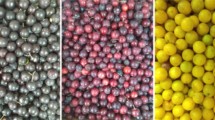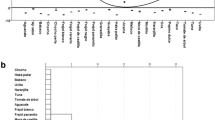Abstract
Tropical forests contain many tree species that have supplied edible fruits for centuries. These fruits have contributed to human diets due to their richness in nutrients, vitamins, minerals, antioxidants and their low anti-nutrients content. We investigated the antioxidant, nutritional and anti-nutritional composition of Garcinia kola and Chrysophyllum albidum fruit parts. The nutritional, anti-nutritional and antioxidant compositions differed depending on the fruit part. Irrespective of fruit part, moisture content was high (72–93 %). While the edible part (fruit pulp) of C. albidum proved a better source of protein (4), fibre (17 %) and fat (2 %), the seed kernel was a better source of ash (2 %) and carbohydrate (15 %). Carbohydrate (22 %), protein (2 %), fat (1 %) and fibre (3 %) were higher in G. kola seed kernel (edible part) than in the pulp and pod. Anti-nutrient content in G. kola and C. albidum fruits was low, indicating that their consumption would not pose nutritional or health problems. The antioxidant compositions (especially phenolic content (10–21 mg·g−1) and DPPH (1,1-diphenyl–2 picrylhydrazyl) (26–55 %)) of C. albidum fruit pulp and G. kola seed kernel were high, implying that they could be good sources of natural antioxidants and could be used as supplements in food manufacturing.

Similar content being viewed by others
References
Abidemi TA, Adebayo OJ, Idowu O, Agbotoba MO (2009) Nutrient content and anti-nutritional factors in shea butter (Butryospermum parkii) leaves. Afr J Biotechnol 8(21):5888–5890
Adebisi AA (2004) A case study of Garcinia kola production-to-consumption system in J4 of Omo forest reserve, southwestern Nigeria. In: Sunderland T, Ndoye O (eds) Forest products, livelihoods and conservation: Case studies of non-timber forest product systems, Vol 2-Africa. Centre for International Forestry Research, Jakarta, pp 115–132. Available at http://www.cifor.org/publications/pdf_files/Books/NTFPAfrica/TOC-Chapter6.PDF. Accessed 14 Nov 2014
Adegoke GO, Kumar MV, Sambaiah K, Lokesh BR (1998) Inhibitory effect of Garcinia kola on the lipid peroxidation in rat liver homogenate. India J Exp Biol 36:907–910
Adepoju OT (2009) Proximate composition and micronutrient potentials of three locally available wild fruits in Nigeria. Afr J Agric Res 4(9):887–892
Amusa NA, Ashaye OA, Oladapo MO (2003) Biodeterioration of the African star apple (Chrysophyllum albidum) in storage and the effect on its food value. Afr J Biotechnol 2(3):56–59
AOAC (2005) Official methods of analysis of the association of official analytical chemist, 18th edn. AOAC International Gaithersburg, Maryland
Ayuk ET, Duguma B, Franzel S, Kengue J, Mollet M, Tiki-Manga T, Zenkeng P (1999) Uses, management and economic potential of Irvingia gabonensis in the humid lowlands of Cameroon. For Ecol Manag 113:1–9
Barany M, Hammett AL, Sene A, Amicher B (2001) Nome timber forest benefits and HIV/AIDS in Sub Saharan Africa. J For 99:36–42
Birk Y, Bondi A, Gestetner B, Ishaya IA (1963) Thermostable hemolytic factor in soybeans. Natural 197:1089–1090
Borokini TI (2014) A systematic compilation of IUCN red-listed threatened plant species in Nigeria. Int J Environ Sci 3(3):104–133
Cao GH, Sofic E, Prior LR (1996) Antioxidant capacity of tea and common vegetables. J Agric Food Chem 44(11):3426–3431
Capasso A (2013) Antioxidant action and therapeutic efficacy of Allium sativum L. Molecules 18:690–700. doi:10.3390/molecules18010690
Chen CW, Ho CT (1995) Antioxidant properties of polyphenols extracted from green and black teas. J Food Lipids 2:35–46
Dosunmu MI, Johnson EC (1995) Chemical evaluation of the nutritive value and changes in ascorbic acid content during storage of the fruit of ‘bitter kola’ (Garcinia kola). Food Chem 54:67–71
Edem DO, Eka OU, Ifon ET (1984) Chemical Evaluation of the value of the fruit of African Star apple (Chrysophyllum albidum). Food Chem 14:303–311
Enujiugha VN (2010) The antioxidant and free radical scavenging capacity of phenolic from African locust bean seeds (Parkia biglobosa). Adv Food Sci 32(2):88–93
FAO (2011) Fruit trees and useful plants in Amazonian life. In: Shanley P, Cymerys M, Serra M, Medina M (eds) Non-wood forest products 20. FAO, CIFOR and People and Plants International. FAO and CIFOR, Rome, p 353. Available at http://www.fao.org/docrep/015/i2360e/i2360e.pdf. Accessed 28 Oct 2013
Farombi EO (2003) African indigenous plants with chemotherapeutic potentials and biotechnological approach to the production of bioactive prophylactic agents. Afr J Biotechnol 2:662–671
FORMECU (1999) Forest resources study, Nigeria. Revised national report, Vol. 2. Prepared for FORMECU by Beak and Geomatics International. Abuja, Nigeria: Federal Department of Forestry, Abuja, Nigeria, p 224
Frazier WC, Westhoff DC (1988) Food microbiology, 4th edn. Tata McGraw Hill Inc., New York, p 540
Getachew A, Kelbessa U, Dawit D (2005) Ethnobotanical study of edible indigenous plants in some selected districts of Ethiopia. Hum Ecol 33(1):83–118
Gulati V, Harding AH, Palombo EA (2012) Enzyme inhibitory and antioxidant activities of traditional medicinal plants: potential application in the management of hyperglycemia. BMC Complement Altern Med 12:77. www.biomedcentral.com/1472-6882/12/77 (please read the example for reference format)
Hamid AA, Aiyelaagbe OO, Usman LA, Ameen OM, Lawal A (2010) Antioxidants: its medicinal and pharmacological applications. Afr J Pure Appl Chem 4(8):142–151
Heimler D, Vignolini P, Dini MG, Romani A (2005) Rapid tests to assess the antioxidant activity of Phaseolus vulgaris L. dry beans. J Agric Food Chem 53:3053–3056
Heinritz SN, Hoedtke S, Martens SD, Peters M, Zeyner A (2012) Evaluation of ten tropical legume forages for their potential as pig feed supplement. Livest Res Rural Dev 24(1). Article #7. Available at http://www.lrrd.org/lrrd24/1/hein24007.htm. Accessed 09 Dec 2013
Hudson BJF, El-Difrawi EA (1979) The sapogenins of the seeds of four lupin species. J Plant Foods 3:181–186
Keay RWJ (1989). Trees of Nigeria. A revised version of “Nigerian Trees” (Keay et al 1964). Clarendon press, Oxford, p 476
Kuhnlein HV (1989) Nutrient values in indigenous wild berries used by the Nuxalk people of Bella Coola, British Columbia. J Food Compos Anal 2:28–36
Larrauri JA, Gõni I, Martin-Carrón N, Rupérez P, Saura-Calixto F (1996) Measurement of health-promoting properties in fruit dietary fibres, antioxidant capacity, fermentability and glucose retardation index. J Sci Food Agric 71:515–519
Leakey RRB (1999) Potential for novel food products from agroforestry trees: a review. Food Chem 66:1–14
Leakey RRB, Tchoundjeu Z, Schreckenberg K, Shackleton SE, Shackleton CM (2005) Agroforestry tree products (AFTPs): targeting poverty reduction and enhanced livelihoods. Int J Agric Sustain 3:1–23
Lee MJ, Pate JS, Harris DJ, Atkins CA (2007) Synthesis, transport and accumulation of quinolizidine alkaloids in Lupinus albus L. and L. angustifolius L. J Exp Bot 58:935–946
Luna-Vázquez FJ, Ibarra-Alvarado C, Rojas-Molina A, Rojas-Molina JI, Yahia EM, Rivera-Pastrana DM, Rojas-Molina A, Zavala-Sánchez MA (2013) Nutraceutical value of black cherry Prunus serotina Ehrh. Fruits: antioxidant and antihypertensive properties. Molecules 18:14597–14612. doi:10.3390/molecules181214597
Mahapatra AK, Mishra S, Basak UC, Panda PC (2012) Nutrient analysis of some selected wild edible fruits of deciduous forests of India: an explorative study towards non-conventional bio-nutrition. Adv J Food Sci Technol 4(1):15–21
Marfo EK, Simpson BK, Idowu JS, Oke OL (1990) Effect of local food processing on phytate level in cassava, cocoyam, yam, maize, sorghum, rice, cowpea and soya beans. J Agric Food Chem 38:1580–1585
Martens SD, Tiemann TT, Bindelle J, Peters M, Lascano CE (2012) Alternative plant protein sources for pigs and chickens in the tropics—nutritional value and constraints: a review. J Agric Rural Dev Trop Subtrop 113(2):101–123
Nikki KE (2001) Free radical in the 1990s from in vitro to in vivo. Free Radic Res 33:693–704
NRC (1993) Nutrient requirements of fish. Committee on Animal Nutrition, Board on Aquaculture National Research Council. National Academy Press, Washington, p 114
Odebunmi EO, Oluwaniyi OO, Awolola GV, Adediji OD (2009) Proximate and nutritional composition of kola nut (Cola nitida), bitter cola (Garcinia cola) and alligator pepper (Afromomum melegueta). Afr J Biotechnol 8(2):308–310
Okafor JC (1991) Improving edible species of forest products. Unasylva 42(165):17–22
Omogbai BA, Ojeaburu SI (2010) Nutritional composition and microbial spoilage of Dacryodes edulis fruits vended in southern Nigeria. Sci World J 5(4):5–10
Onyekwelu JC, Stimm B (2006) Irvingia gabonensis, (Aubrey-Lecomte ex O. Rorke) Baill. In: Schütt P, Weisgerber H, Lang U, Roloff A, Stimm B (eds) Enzyklopädie der Holzgewächse. Ecomed-Verlag, Munich, 43.Erg.Lfg. 03/06, p 14
Onyekwelu JC, Stimm B (2011) Chrysophyllum albidum. In: Roloff A, Weisgerber H, Lang U, Stimm B (eds) Enzyklopädie der Holzgewächse. Wiley-VCH, Weinheim, 59. Erg.Lfg. 10/11, p 12
Onyekwelu JC, Stimm B, Mosandl R, Olusola JA (2011) Domestication of Chrysophyllum albidum from rainforest and derived savannah ecosystems—phenotype variation and selection of elite trees. Paper accepted for presentation at Tropentag, 5–7th November 2011, Bonn, Germany. http://www.tropentag.de/2011/abstracts/full/462.pdf. Accessed 10 Jan 2013
Onyekwelu JC, Olusola JA, Stimm B, Mosandl R, Agbelade DA (2014) Farm-level tree growth characteristics, fruit phenotypic variation and market potential assessment of three socioeconomically important forest fruit tree species. For Trees Livelihoods. doi:10.1080/14728028.2014.942386
Price ML, Van Scooc S, Butler LG (1978) A critical evaluation of the vanillin reaction as an assay for tannins and sorghum grain. J Agric Food Chem 26:12–14
Rathod VS, Valvi SR (2011) Anti-nutritional factors of some wild edible fruits from Kolhapur district. Recent Res Sci Technol 3(5):68–72
Richfort S, Panozzo J (2007) Phytochemicals for health, the role of pulses. J Agric Food Chem 55(20):7981–7994
Sánchez-Castillo CP, Hudson GJ, Englyst HN, Dewey P, Philip W, James T (2002) The importance of dietary carbohydrates. Arch Latinoam Nutr 52(4):321–335
Sanchez-Moreno C, Larrauri JA, Saura-Calixto FA (1998) A procedure to measure the antiradical efficiency of Polyphenols. J Sci Food Agric 76:270–276
Shahidi F, Naczk M (1995) Phenolic compounds in grains. Food Phenolics, source, chemistry effects applications. Technomic Publishing Company Inc., Lancaster PA, pp 3–39
Siddhuraju P, Becker K (2007) The antioxidant and free radical scavenging activities of processed cowpea (Vigna unguiculata (L.) Walp.) seed extracts. Food Chem 101:10–19
Sim K, Nurestri AS, Norhanom A (2010) Phenolic content and antioxidant activity of Pereskia grandifolia Haw. (Cactaceae) extracts. Pharmacogn Mag 6:248–254
Singleton VI, Lamuella-Raventos RM (1999) Analysis of total phenols and other oxidation substrates and antioxidants by means of Folin-ciocalteu reagent. Methods Enzymol 299:152–178
Sreeramulu D, Raghunath M (2011) Antioxidant and phenolic content of nuts, oil seeds, milk and milk products commonly consumed in India. Food Nutr Sci 2:422–427
Sundriyal M, Sundriyal RC (2003) Underutilized edible plants of the Sikkim Himalaya: need for domestication. Curr Sci 85(6):731–736
Takeoka RG, Dao TL (2003) Antioxidant constituents of almond hulls. J Agric Food Chem 51(20):496–501
Valko M, Leibfritz D, Moncola J, Cronin MTD, Mazur M, Telser J (2007) Free radicals and antioxidants in normal physiological functions and human disease. Int J Biochem Cell Biol 39:44–84
Wheeler EL, Ferrel RE (1971) A method for phytic acid determination in wheat fractions. Cereals Chem 48:312–320
Acknowledgments
This study was part of a larger study on “Domestication of some important indigenous forest food tree species—phenotype variation, selection and nursery investigation” sponsored by Alexander von Humboldt Foundation (AvH), Bonn, Germany. The authors are grateful to the AvH for financially supporting this work under the Research Group Linkage Programme of the AvH.
Author information
Authors and Affiliations
Corresponding author
Additional information
Project funding: This work was supported by Alexander von Humboldt Foundation (AvH), Bonn, Germany.
The online version is available at http://www.springerlink.com
Corresponding editor: Zhu Hong
Rights and permissions
About this article
Cite this article
Onyekwelu, J.C., Oyewale, O., Stimm, B. et al. Antioxidant, nutritional and anti-nutritional composition of Garcinia kola and Chrysophyllum albidum from rainforest ecosystem of Ondo State, Nigeria. J. For. Res. 26, 417–424 (2015). https://doi.org/10.1007/s11676-015-0068-2
Received:
Accepted:
Published:
Issue Date:
DOI: https://doi.org/10.1007/s11676-015-0068-2




